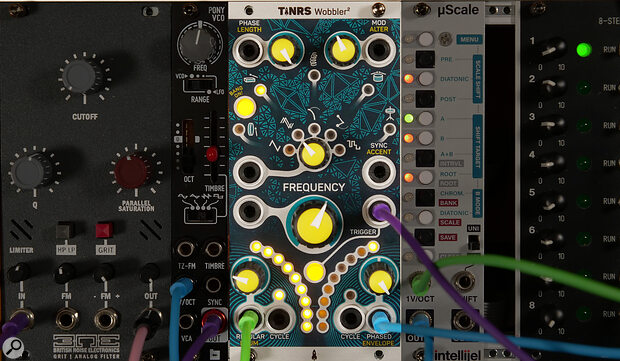The original Wobbler LFO module was released in 2018 and offered a controlled but chaotic approach to modulation. You had five different modes starting with comfortably predictable shapes before spinning off into physically modelled movements of Twang and Double Pendulum and ending up self‑phased and sampled & held. The interface was lively and animated, inviting modulation of the modulators, and was brilliantly visualised in the dual‑LED modulation handlebars.
However, we’re not here to discuss what it used to do. When going into production on a new run of Wobblers, This Is Not Rocket Science discovered that the critical microcontroller at the centre of the module had fallen foul to the chip shortage. After swapping to a Raspberry Pi‑based alternative, TINRS found itself with a whole load of space and power to spare. And what could be more natural than to fill that space with an entire drum synthesizer?
Hit the ‘Bang On!’ button, and the physical modelling engine generates an arc of five ‘regions of drum’, and everything that was once LFO‑intended is repurposed for percussive enterprises. The five regions include a Big Drum for kicks and toms; Block for woodblock sounds; Sproing, which is exactly as it sounds; Snare Drum for some noise‑based action; and Hi‑hat for some inharmonic, noise‑laden clatterings. The regions react differently to the two modulation knobs. The left one tends to set the length or decay, whereas the right one can pull in everything from zaps, to noise, to flip‑flopping, dimension‑changing clangs and wibbles. It’s good to see the chaotic nature of the original module infecting all the new stuff.
In Use
In use, it’s a linear drum sound source with a similar vibe to the Noise Engineering Basimilus Iteritas Alter or Moog DFAM but with a far weirder and more versatile sound set. By modulating the regions, you can swap sounds on every trigger to give a constantly changing cascade of rhythms. And, as with the LFO waveforms, the regions mix from one to the other, so you can find interesting sounds between the sounds. I initially found it tricky to select the regions accurately over CV because it expects ‑5V to +5V. That’s fine for an LFO, but I wanted to sequence the sounds, and most sequencers tend to run from 0‑10 V. I was able to solve the problem by using the programmable bipolar modulation output of the Erica Synths Black Sequencer, but maybe including an option to make this input unipolar in a firmware update would be helpful?
TINRS have squeezed in some additional features that you didn’t know you needed. The output can either be compressed or distorted to one degree or another. The decay envelope of the triggered sound gets its own output. The cycle outputs become a gate, and an inverted gate, and every region has an individual response to the accent input. And then, like an afterthought, you discover it also has seven sample‑based drum kits inside ranging from big ’80s snares to arcade sounds and vocal yelping. It’s a bit bonkers.
Wobbler2 leaves you with a conundrum. Am I going to use it for modulation, or am I going to embrace the beats? The LFO side is excellent, unusual and fun to be around, but the drum synth is the most excitement I’ve had from percussion in ages. It’s like having two alternative firmwares in one module that have no business being together. I guess I’ll have to get two.
£342
www2.thisisnotrocketscience.nl
$389

